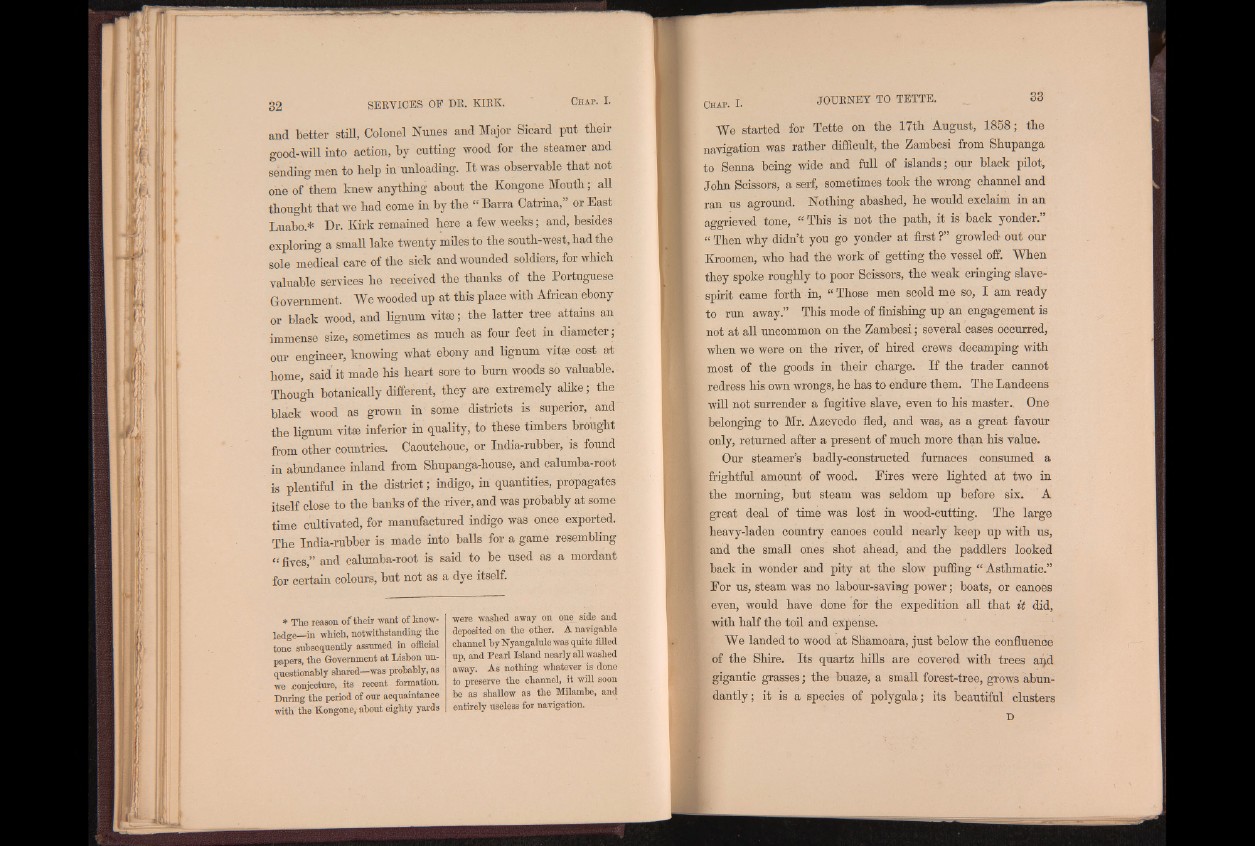
and better still, Colonel Nunes and Major Sicard put their
good-will into action, by cutting wood for the steamer and
sending men to help in unloading. I t was observable that not
one of them knew anything about the Kongone Mouth; all
thought that we had come in by the. “ Barra Catrina, or East
Luabo.* Dr. Kirk remained here a few.weeks; and, besides
exploring a s™«H lake twenty miles to the south-west, had the
sole medical care of the sick and wounded soldiers, for which
valuable services he received the thanks of the Portuguese
Government. We wooded up at this place with African ebony
or black wood, and lignum vitse; the latter tree attains an
immense size, sometimes as much as four feet in diameter;
our engineer, knowing what ebony and lignum vitse cost at
home, said it made his heart sore to bum woods so valuable.
Though botanically different, they are extremely alike; the
black wood as grown in some districts is superior, and
the lignum vitae inferior in quality, to these timbers brought
from other countries. Caoutchouc, or India-rubber, is found
in abundance inland from Shupanga-house, and calumba-root
is plentiful in the district; indigo, in quantities, propagates
itself close to the banks of the river, and was probably at some
time cultivated, for manufactured indigo was once exported.
The India-rubber is made into balls for a game resembling
“ fives,” and calumba-root is said to be used as a mordant
for certain colours, but not as a dye itself.
* The reason of their -want of knowledge
in which, notwithstanding the
tone subsequently assumed in official
papers, the Government at Lisbon unquestionably
shared—was probably, as
we .conjecture, its recent formation.
During the period of our acquaintance
with the Kongone, about eighty yards
were washed away on one side and
deposited on the other. A navigable
channel by Nyangalule was quite filled
up, and Pearl Island nearly all washed
away. As nothing whatever is done
to preserve the channel, it will soon
be as shallow as the Milambe, and
entirely useless for navigation.
We started for Tette on the 17th August, 1858; the
navigation was rather difficult, the Zambesi from Shupanga
to Senna being wide and full of islands; our black pilot,
John Scissors, a serf, sometimes took the wrong channel and
ran us aground. Nothing abashed, he would exclaim in an
aggrieved tone, “ This is not the path, it is back yonder.”
“ Then why didn’t you go yonder at first ?” growled out our
Kroomen, who had the work of getting the vessel off. When
they spoke roughly to poor Scissors, the weak cringing slave-
spirit came forth in, “ Those men scold me so, I am ready
to run away.” This mode of finishing up an engagement is
not at all uncommon on the Zambesi; several cases occurred,
when we were on the river, of hired crews decamping with
most of the goods in their charge. I f the trader cannot
redress his own wrongs, he has to endure them. The Landeens
will not surrender a fugitive slave, even to his master.. One
belonging to Mr. Azevedo fled, and was, as a great favour
only, returned after a present of much more than his value.
Our steamer’s badly-constructed furnaces consumed a
frightful amount of wood. Fires were lighted at two in
the morning, but steam was seldom up before six. A
great deal of time was lost in wood-cutting. The large
heavy-laden country canoes could nearly keep up with us,
and the small ones shot ahead, and the paddlers looked
back in wonder and pity at the slow puffing “ Asthmatic.”
For us, steam was no labour-saving power; boats, or canoes
: even, would have done for the expedition all that it did,
with half the toil and expense.
We landed to wood at Shamoara, just below the confluence
of the Shire. Its quartz hills are covered with trees aqd
; gigantic grasses; the buaze, a small forest-tree, grows abun-
: dantly; it is a species of polygala; its beautiful clusters